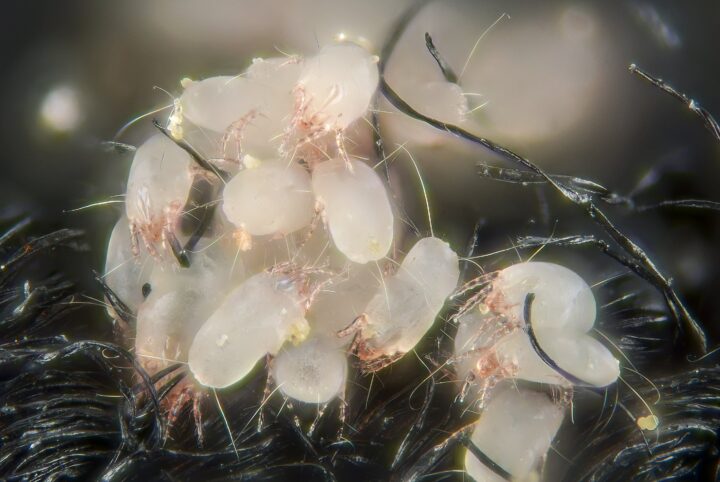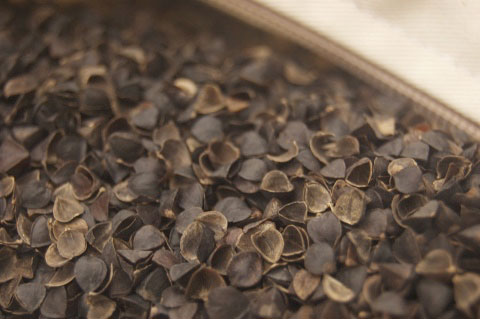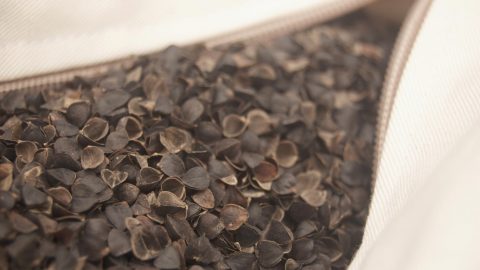In short, no, buckwheat pillows do not attract bugs. Buckwheat flour and other cereal products can provide insects sustenance, but the empty hulls that buckwheat pillows are filled with are not edible.
But wait… some kinds of insects are inside all pillow types!
Dust mites are the real bug menace and unfortunately no pillow type is immune to them.

Dust mites are one of the top five most common allergens. The effects of a dust mite allergy are very similar to a pollen allergy.
“Dust mites are microscopic creatures, about 0.4 millimeters in length, that feast on flakes of human skin. Their feces contains a substance called DerP1, a very potent allergen. People who are allergic to dust mites may have asthmalike symptoms, eczema or chronic sinus problems.” NYTimes.com
Some buckwheat pillow manufacturers claim that their pillows are dust mite resistant. Not true. They’re no better or worse at resisting dust mites than any other type. Unfortunately no pillow, not even so-called “hypoallergenic pillows” are immune to dust mites.
With use, your pillow will inevitably accumulate small particles of organic materia. Dust mites crave this stuff. Every night you sleep on your pillow, you leave behind delicious dead skin for dust mites and their happy families!
What can you do to avoid dust mites?
- Lower the humidity in your home. Dust mites only appear in humid environments. Homes with a relative humidity of less than 50% aren’t likely to host dust mites.
- Use dust mite covers. These are generally vinyl or plastic covers that prevent foreign materials from getting inside your pillow. While most experts recommend them, they are still somewhat controversial. An unfortunate drawback to dust mite covers is that they will prevent air from moving freely through your pillow. This can result in it retaining heat and being uncomfortable.
- Take extra care to keep your pillows clean. Wash your pillowcase frequently.
Should I be concerned about dust mites if I’m not allergic?
I’ve read some pretty shocking claims about dust mites. Despite the (likely exaggerated) stories, dust mites aren’t something most of us should be too concerned about. They will not take up residence in your bedding unless the circumstances are just right. Even if a few of them do, they’re not going to cause any trouble unless you’re allergic to them.

Dust mites are the most common insect scenario to pop up in a buckwheat pillow, but there are other possibilities.
However improbable, tiny grain beetles can exist in some pillow fill types like buckwheat hulls or millet, but only under the right conditions.
To understand, first let’s look at how buckwheat hulls are produced. The buckwheat plant is milled for the nutritious groats it produces. During the milling process, the groat is separated from its protective outer layer, the hull. Then the hulls are vacuum cleaned to remove any remaining groats or other plant materials. A few types of very tiny grain beetles eat buckwheat flour, and other cereal products like rice.
Despite vigorous vacuum cleaning of buckwheat hulls, tiny amounts of flour can remain. In a hot and humid storage facility, this trace flour can provide food for insect larvae. However, infestation risks are easily mitigated by maintaining a climate-controlled warehouse.
That’s because most grain beetles cannot reproduce in a cool, dry environment. Their optimal conditions for development are 95 degrees F and 70% relative humidity. Studies show they are incapable of producing eggs where temperature and humidity remain low.
Mills producing cereal products like buckwheat flour must all contend with a few manageable insect pests.
Industrial mills closely monitor their storage. They consistently maintain cool temperatures and keep the humidity low. Additionally, they’re frequently cleaning storage and transport devices.
At Hullo™ we don’t handle any flours, cereals, or other products that can cause bug infestations. Nevertheless, we take several precautions to ensure that our buckwheat hulls are always 100% bug-free. To keep our facilities and products insect-free, we:
- keep our inventory in a climate controlled warehouse.
- meticulously clean our warehouses and machinery.
- use pheromone traps throughout our facility to detect the presence of insects.
- work with a professional entomologist and periodically send buckwheat hull samples to a lab for testing.
- communicate regularly with our buckwheat hull providers upstream who also monitor regularly for insects.



